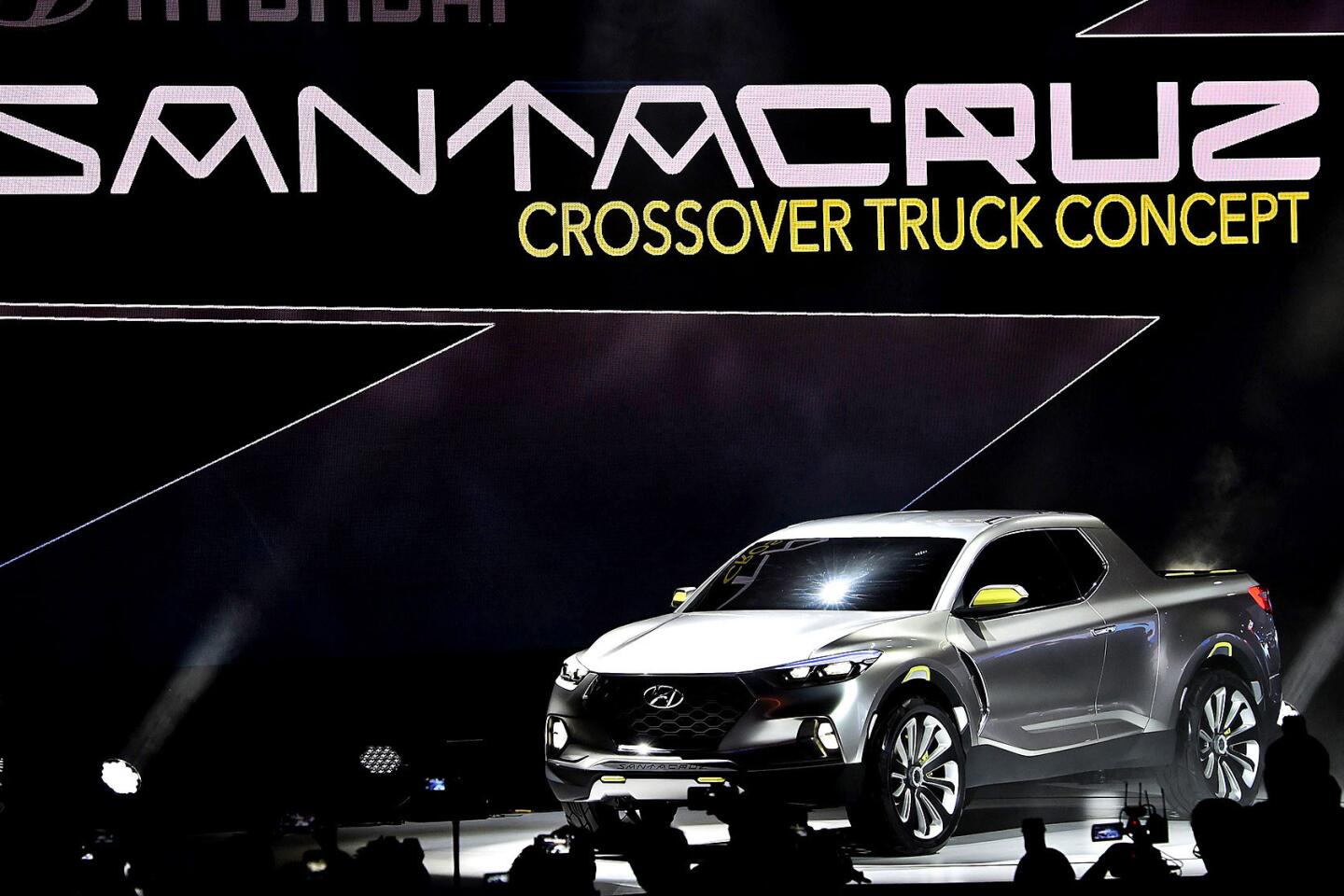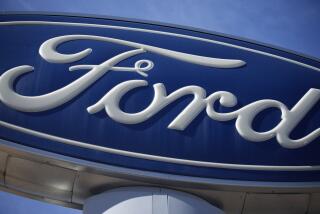New pickups rock Detroit, roll into 2015
- Share via
Toyota to General Motors: Bring it on.
The Japanese automaker delivered a counterpunch this week in the mid-size truck segment with the unveiling of an all-new Toyota Tacoma.
The Detroit debut answered GM’s launch of the Chevy Colorado and GMC Canyon, sibling pickups that have quickly picked up accolades since they went on sale late last year. The budding rivalry has fired up the mid-size truck segment, which had seen sales defect to crossover SUVs and full-size trucks.
It was one of several high-profile truck debuts at the North American International Auto Show. Nissan unveiled its long-overdue Titan XD full-size truck, Ford Performance brought out the 2017 F-150 Raptor off-road beast and Ram introduced a trail-friendly version of its 1500 truck called the Rebel.
Their timing couldn’t be better. With gas prices plunging, consumers are again eyeing larger, less fuel-efficient vehicles. And trucks are less thirsty than they once were.
Toyota Tacoma
For the last decade, the previous-generation Tacoma dominated the mid-size truck world, while brands like Ford and Ram fled, citing weak demand. Even GM’s earlier efforts were afterthoughts by the automaker’s own admission.
But with the Tacoma and Nissan’s Frontier both aging, the new Chevy Colorado and GMC Canyon leapt onto the market last year. They posed a credible threat to Toyota’s stranglehold, thanks to heaps of refinement, capability and style.
The new 2016 Tacoma hopes to stave off that threat.
Selling at a clip of about 150,000 a year, the Tacoma has a loyal fan base. With the new competition from GM, it’s crucial for Toyota to get the new Tacoma right.
“It’s a big deal,” said Mike Wall, an automotive analyst at IHS. The Tacoma “has a healthy amount of loyalty, but frankly it’s a vehicle that’s so long in the tooth, it’s vital that they come out with a really solid successor.”
The truck comes with an all-new optional engine, a direct-injected V-6 that will be more powerful and more efficient than the 4.0-liter V-6 it replaces. The Tacoma’s base four-cylinder engine carries over from the earlier model. A new six-speed automatic transmission will be standard with both engines, although V-6 buyers can opt for a six-speed manual gearbox.
The truck gets a more rugged exterior, along with more high-strength steel in the truck’s frame and body shell for durability. Acoustic glass and sound deadening throughout the cabin make it more quiet. All models also come with a GoPro camera mount near the rear-view mirror.
Optional creature comforts include a wireless charging spot for smartphones, leather seats, moon roof, touch-screen audio systems and blind-spot monitoring.
Upgrades like these bode well for Toyota maintaining its sales lead, especially considering that truck buyers are among the most loyal in the entire automotive industry.
“Everyone from gardeners to off-road enthusiasts drives Tacomas,” said Dave Sullivan, manager of product analysis at AutoPacific. “They’re the envy of GM right now, and GM can’t understand how Toyota can sell that many Tacomas every year even when it’s dated.”
Nissan Titan XD
Nissan is also hoping to make a truck statement. It used the Detroit show to debut the second generation of its Titan full-size truck.
Designed in La Jolla by Diane Allen, the 2016 Titan XD goes on sale toward the end of this year and replaces a model that’s been around since 2003.
Though initially well-received, the Titan’s later years were besieged by poor sales because of intense competition from Ford, GM and Ram. Over the last three years, Nissan’s Titan has averaged about 16,600 sales annually. In the same period, Ford averaged that many F-Series trucks every week and a half.
So why would Nissan bother investing the time and money in an all-new Titan? Profit.
“There is a lot of money to be made in this segment,” said Wall, the IHS analyst. “There’s room at the upper end of the market to make even more.”
Nissan hopes that the Titan XD can carve out a unique niche for itself in the otherwise crowded field. This model’s size and capabilities put it between a traditional full-size truck and a heavy-duty model.
Nissan says about 150,000 truck customers a year move up and down between the two sizes, and it hopes that this new Titan XD will fill that white space. A turbocharged diesel V-8 engine also sets it apart from the pack, which could be an added draw for buyers.
In a nod to the exploding market in luxury trucks — in the neighborhood of $50,000 — Nissan will add the Platinum Reserve model. And a traditionally sized Titan will be announced later this year.
Ram 1500 Rebel
Also in Detroit, Ram brought the 1500 Rebel, a new trim level on its popular full-size truck lineup that saw sales jump nearly 24% in 2014. The Rebel turns its gaze off-road, and adds a more aggressive suspension, tires and wheels, as well as new bumpers and grille.
Ford F-150 Raptor
Ford’s performance division debuted an all-new F-150 Raptor, a high-speed off-road seeker with a new turbocharged V-6 replacing the earlier model’s V-8. The 2017 Raptor hits the market in 2016 with more than 400 horsepower and 500 pounds of weight trimmed off the old model, thanks to aluminum body panels.
Hyundai Santa Cruz concept
Then there’s the Santa Cruz crossover truck concept. Picture a sleek, modern Chevy El Camino on stilts with two full-size doors and two small, rear-hinged doors.
Hyundai was hurt in the last year by being a car-centric brand even as the market shifted to favor trucks and sport-utility vehicles, said Dave Zuchowski, chief executive of Hyundai Motor America.
It’s making a push to get a larger share of the South Korean automaker’s SUV and crossover production to sell in the U.S. market and is looking at new options such as the Santa Cruz concept vehicles it showed in Detroit, Zuchowski said.
The marketing team at Hyundai believes there is a large population of consumers who don’t see themselves driving a pickup. Either the vehicles are too large and hard to park in the urban environments where these drivers live or they are too expensive — a typical well-equipped full-size pickup can approach a $40,000 sticker price.
Yet these consumers still want truck-like features in a vehicle such as the ability to toss lumber, dirty bikes, kayaks and other equipment in the back without spoiling the auto’s interior, said Mark Dipko, director, corporate planning, Hyundai Motor America.
A unique feature of the Santa Cruz is a section that expands out the rear of the vehicle, increasing the size of the cargo bed to almost that of a midsize pickup truck.
“This new crossover allows them all the expandable utility they need throughout their active week, from work-life professionalism, to social interests, to a whole variety of outdoor pursuits,” he said.
Hyundai created the truck-crossover mashup because “we didn’t want to cover the same ground as a tradition truck,” Dipko said.
Hyundai doesn’t currently have plans to put the Santa Cruz into production, content to simply use the concept to gauge consumer reaction.










